Antidiabetic and Antigout Properties of the Ultrasound-Assisted Extraction of Total Biflavonoids from Selaginella doederleinii Revealed by In Vitro and In Silico Studies
Abstract
:1. Introduction
2. Materials and Methods
2.1. Chemicals and Reagents
2.2. Establishment of Analytical Methods
2.2.1. Determination of Total Biflavonoids (TF) Content
2.2.2. Determination of Major Biflavonoids
2.3. Optimization of SD Extraction Process
2.3.1. One-Way Experiment
2.3.2. Response-Surface Methodology (RSM)
2.4. Purification of SD Extracts
2.4.1. Preparation of the Extract
2.4.2. Comparison of Different Fillers
2.4.3. Effect of Methanol Concentration
2.4.4. Effect of Elution Flow Rate
2.4.5. Effect of Sample Concentration
2.5. Enzyme Inhibition Assay of SD Purifications
2.5.1. Inhibitory Activity of α-Glucosidase (AG)
2.5.2. Inhibitory Activity of α-Amylase
2.5.3. Inhibitory Activity of Xanthine Oxidase (XOD)
2.6. Molecular Docking of Oxidative Enzymes
2.6.1. Ligand and Receptor Structure Preparation
2.6.2. Docking
2.7. Molecular Dynamic Simulation Method
2.8. Statistical Analysis
3. Results and Discussion
3.1. Analysis of the Extraction Process
3.1.1. One-Way Experiment Analysis
3.1.2. RSM Optimized Extraction Process
3.2. Effect of Purification Conditions
3.2.1. Effect of Different Fillers
3.2.2. Selection of Methanol Concentration
3.2.3. Selection of Elution Flow Rate
3.2.4. Selection of Sample Concentration
3.3. Validation of the Methodology
3.4. Enzyme Inhibitory Activity of SDTB Purifications
3.4.1. AG Inhibitory Activity
3.4.2. α-Amylase Inhibitory Activity
3.4.3. XOD Inhibitory Activity
3.5. Molecular Docking
3.6. Molecular Dynamic
4. Conclusions
Supplementary Materials
Author Contributions
Funding
Institutional Review Board Statement
Informed Consent Statement
Data Availability Statement
Conflicts of Interest
References
- Muema, F.W.; Liu, Y.; Zhang, Y.; Chen, G.; Guo, M. Flavonoids from Selaginella doederleinii Hieron and Their Antioxidant and Antiproliferative Activities. Antioxidants 2022, 11, 1189. [Google Scholar] [CrossRef] [PubMed]
- Liu, L.-F.; Sun, H.-H.; Tan, J.-B.; Huang, Q.; Cheng, F.; Xu, K.-P.; Zou, Z.-X.; Tan, G.-S. New Cytotoxic Biflavones from Selaginella doederleinii. Nat. Prod. Res. 2021, 35, 930–936. [Google Scholar] [CrossRef]
- Lin, F.; Lin, X.; Wang, X.; Mei, G.; Chen, B.; Yao, H.; Huang, L. Inhibitory Effect of Selaginella doederleinii Hieron on Human Cytochrome P450. Front. Pharmacol. 2023, 14, 1108867. [Google Scholar] [CrossRef] [PubMed]
- Wang, S.; Wan, D.; Liu, W.; Kang, X.; Zhou, X.; Sefidkon, F.; Hosseini, M.M.Z.; Zhang, T.; Pan, X.; Yang, X. A Biflavonoid-Rich Extract from Selaginella doederleinii Hieron. against Throat Carcinoma via Akt/Bad and IKKβ/NF-κB/COX-2 Pathways. Pharmaceuticals 2022, 15, 1505. [Google Scholar] [CrossRef] [PubMed]
- Chen, M.; Wang, S.; Cheng, H.; Wan, D.; Lu, R.; Yang, X. Seladoeflavones G-I, Three New Flavonoids from Selaginella doederleinii Hieron. ChemistrySelect 2022, 7, e202202242. [Google Scholar] [CrossRef]
- Lee, N.-Y.; Min, H.-Y.; Lee, J.; Nam, J.-W.; Lee, Y.-J.; Han, A.-R.; Wiryawan, A.; Suprapto, W.; Lee, S.K.; Seo, E.-K. Identification of a New Cytotoxic Biflavanone from Selaginella doederleinii. Chem. Pharm. Bull. 2008, 56, 1360–1361. [Google Scholar] [CrossRef]
- Li, S.; Zhao, M.; Li, Y.; Sui, Y.; Yao, H.; Huang, L.; Lin, X. Preparative Isolation of Six Anti-Tumour Biflavonoids from Selaginella doederleinii Hieron by High-Speed Counter-Current Chromatography. Phytochem. Anal. 2014, 25, 127–133. [Google Scholar] [CrossRef]
- Li, S.; Yao, H.; Zhao, M.; Li, Y.; Huang, L.; Lin, X. Determination of Seven Biflavones of Selaginella doederleinii by High Performance Liquid Chromatography. Anal. Lett. 2013, 46, 2835–2845. [Google Scholar] [CrossRef]
- Lin, R.C.; Skaltsounis, A.-L.; Seguin, E.; Tillequin, F.; Koch, M. Phenolic Constituents of Selaginella doederleinii. Planta Med. 1994, 60, 168–170. [Google Scholar] [CrossRef]
- Chao, L.R.; Seguin, E.; Skaltsounis, A.-L.; Tillequin, F.; Koch, M. Synthesis of the Glycoalkaloids of Selaginella doederleinii and Structure Revision of One of Them. J. Nat. Prod. 1990, 53, 882–893. [Google Scholar] [CrossRef]
- Lin, R.C.; Peyroux, J.; Seguin, E.; Koch, M. Hypertensive Effect of Glycosidic Derivatives of Hordenine Isolated from Selaginella doederleinii Hieron and Structural Analogues in Rats. Phytother. Res. 1991, 5, 188–190. [Google Scholar] [CrossRef]
- Li, G.; Gao, X.; Qin, G.; Lei, J.; Jiang, Y.; Linghu, L.; Zhang, C.; Zhang, J.; Wang, Y.; Wang, M.; et al. Purification of Biflavonoids from Selaginelladoe derleinii Hieron by Special Covalent Organic Polymers Material. J. Chromatogr. A 2022, 1668, 462920. [Google Scholar] [CrossRef] [PubMed]
- Li, S.; Zhu, R.; Zhong, M.; Zhang, Y.; Huang, K.; Zhi, X.; Fu, S. Effects of Ultrasonic-Assistant Extraction Parameters on Total Flavones Yield of Selaginella doederleinii and Its Antioxidant Activity. J. Med. Plants Res. 2010, 4, 1743–1750. [Google Scholar] [CrossRef]
- Lin, S.; Chen, Z.; Li, S.; Chen, B.; Wu, Y.; Zheng, Y.; Huang, J.; Chen, Y.; Lin, X.; Yao, H. Anti-Tumor Effect and Mechanism of the Total Biflavonoid Extract from S. doederleinii on Human Cervical Cancer Cells in Vitro and in Vivo. Heliyon 2024, 10, e24778. [Google Scholar] [CrossRef]
- Lee, C.-W.; Choi, H.-J.; Kim, H.-S.; Kim, D.-H.; Chang, I.-S.; Moon, H.T.; Lee, S.-Y.; Oh, W.K.; Woo, E.-R. Biflavonoids Isolated from Selaginella tamariscina Regulate the Expression of Matrix Metalloproteinase in Human Skin Fibroblasts. Bioorg. Med. Chem. 2008, 16, 732–738. [Google Scholar] [CrossRef] [PubMed]
- Bajpai, V.K.; Park, I.; Lee, J.; Shukla, S.; Nile, S.H.; Chun, H.S.; Khan, I.; Oh, S.Y.; Lee, H.; Huh, Y.S.; et al. Antioxidant and Antimicrobial Efficacy of a Biflavonoid, Amentoflavone from Nandina domestica in Vitro and in Minced Chicken Meat and Apple Juice Food Models. Food Chem. 2019, 271, 239–247. [Google Scholar] [CrossRef]
- Yu, S.; Yan, H.; Zhang, L.; Shan, M.; Chen, P.; Ding, A.; Li, S.F.Y. A Review on the Phytochemistry, Pharmacology, and Pharmacokinetics of Amentoflavone, a Naturally-Occurring Biflavonoid. Molecules 2017, 22, 299. [Google Scholar] [CrossRef] [PubMed]
- Zheng, X.; Li, Y.; Zhang, L.; Feng, W.; Zhang, X. Antihyperglycemic Activity of Selaginella tamariscina (Beauv.) Spring. J. Ethnopharmacol. 2011, 133, 531–537. [Google Scholar] [CrossRef]
- Xu, D.; Wang, X.; Huang, D.; Chen, B.; Lin, X.; Liu, A.; Huang, J. Disclosing Targets and Pharmacological Mechanisms of Total Bioflavonoids Extracted from Selaginella doederleinii against Non-Small Cell Lung Cancer by Combination of Network Pharmacology and Proteomics. J. Ethnopharmacol. 2022, 286, 114836. [Google Scholar] [CrossRef] [PubMed]
- Liu, H.; Peng, H.; Ji, Z.; Zhao, S.; Zhang, Y.; Wu, J.; Fan, J.; Liao, J. Reactive Oxygen Species-Mediated Mitochondrial Dysfunction Is Involved in Apoptosis in Human Nasopharyngeal Carcinoma CNE Cells Induced by Selaginella doederleinii Extract. J. Ethnopharmacol. 2011, 138, 184–191. [Google Scholar] [CrossRef]
- Zhang, X.; Zhu, J.; Zeng, Y.; Jiang, P.; Yi, N.; Yan, L.; Li, Y. Numerical Analysis for Liquefaction Deformation of Low Embankment on Soft Foundation Based on Water Level Changes in Coastal Highway. J. Coast. Res. 2019, 94, 321–326. [Google Scholar] [CrossRef]
- Frota, L.S.; Alves, D.R.; Marinho, M.M.; da Silva, L.P.; Almeida Neto, F.W.d.Q.; Marinho, E.S.; de Morais, S.M. Antioxidant and Anticholinesterase Activities of Amentoflavone Isolated from Ouratea fieldingiana (Gardner) Engl. through in Vitro and Chemical-Quantum Studies. J. Biomol. Struct. Dyn. 2023, 41, 1206–1216. [Google Scholar] [CrossRef]
- Jeong, E.J.; Hwang, L.; Lee, M.; Lee, K.Y.; Ahn, M.-J.; Sung, S.H. Neuroprotective Biflavonoids of Chamaecyparis obtusa Leaves against Glutamate-Induced Oxidative Stress in HT22 Hippocampal Cells. Food Chem. Toxicol. 2014, 64, 397–402. [Google Scholar] [CrossRef] [PubMed]
- Li, H.; Yang, J.; Wang, M.; Ma, X.; Peng, X. Studies on the Inhibition of α-Glucosidase by Biflavonoids and Their Interaction Mechanisms. Food Chem. 2023, 420, 136113. [Google Scholar] [CrossRef]
- Wang, Y.; Zhang, G.; Pan, J.; Gong, D. Novel Insights into the Inhibitory Mechanism of Kaempferol on Xanthine Oxidase. J. Agric. Food Chem. 2015, 63, 526–534. [Google Scholar] [CrossRef] [PubMed]
- Tomic, D.; Shaw, J.E.; Magliano, D.J. The Burden and Risks of Emerging Complications of Diabetes Mellitus. Nat. Rev. Endocrinol. 2022, 18, 525–539. [Google Scholar] [CrossRef]
- Crawley, W.T.; Jungels, C.G.; Stenmark, K.R.; Fini, M.A. U-Shaped Association of Uric Acid to Overall-Cause Mortality and Its Impact on Clinical Management of Hyperuricemia. Redox Biol. 2022, 51, 102271. [Google Scholar] [CrossRef] [PubMed]
- Grochowski, D.M.; Uysal, S.; Aktumsek, A.; Granica, S.; Zengin, G.; Ceylan, R.; Locatelli, M.; Tomczyk, M. In Vitro Enzyme Inhibitory Properties, Antioxidant Activities, and Phytochemical Profile of Potentilla thuringiaca. Phytochem. Lett. 2017, 20, 365–372. [Google Scholar] [CrossRef]
- Chen, J.; Huang, Q.; He, Z.; Tan, G.; Zou, Y.; Xie, J.; Qian, Z. Screening of Tyrosinase, Xanthine Oxidase, and α-Glucosidase Inhibitors from Polygoni Cuspidati Rhizoma et Radix by Ultrafiltration and HPLC Analysis. Molecules 2023, 28, 4170. [Google Scholar] [CrossRef]
- Gulati, H.K.; Khanna, A.; Kumar, N.; Sharma, A.; Rupali; Jyoti; Singh, J.; Bhagat, K.; Bedi, P.M.S. Triazole Derivatives as Potential Xanthine Oxidase Inhibitors: Design, Enzyme Inhibition Potential, and Docking Studies. Arch. Pharm. 2024, 357, 2300296. [Google Scholar] [CrossRef] [PubMed]
- Acquaviva, A.; Nilofar; Bouyahya, A.; Zengin, G.; Di Simone, S.C.; Recinella, L.; Leone, S.; Brunetti, L.; Uba, A.I.; Cakilcioğlu, U.; et al. Chemical Characterization of Different Extracts from Artemisia Annua and Their Antioxidant, Enzyme Inhibitory and Anti-Inflammatory Properties. Chem. Biodivers. 2023, 20, e202300547. [Google Scholar] [CrossRef]
- Saleem, H.; Yaqub, A.; Rafique, R.; Ali Chohan, T.; Malik, D.-S.; Tousif, M.I.; Khurshid, U.; Ahemad, N.; Ramasubburayan, R.; Rengasamy, K.R. Nutritional and Medicinal Plants as Potential Sources of Enzyme Inhibitors toward the Bioactive Functional Foods: An Updated Review. Crit. Rev. Food Sci. Nutr. 2023, 25, 1–24. [Google Scholar] [CrossRef] [PubMed]
- Song, D.; Zhao, H.; Wang, L.; Wang, F.; Fang, L.; Zhao, X. Ethanol Extract of Sophora japonica Flower Bud, an Effective Potential Dietary Supplement for the Treatment of Hyperuricemia. Food Biosci. 2023, 52, 102457. [Google Scholar] [CrossRef]
- Do, Q.D.; Angkawijaya, A.E.; Tran-Nguyen, P.L.; Huynh, L.H.; Soetaredjo, F.E.; Ismadji, S.; Ju, Y.-H. Effect of Extraction Solvent on Total Phenol Content, Total Flavonoid Content, and Antioxidant Activity of Limnophila aromatica. J. Food Drug Anal. 2014, 22, 296–302. [Google Scholar] [CrossRef] [PubMed]
- Lei, J.; Wang, Y.; Li, W.; Fu, S.; Zhou, J.; Lu, D.; Wang, C.; Sheng, X.; Zhang, M.; Xiao, S.; et al. Natural Green Deep Eutectic Solvents-Based Eco-Friendly and Efficient Extraction of Flavonoids from Selaginella Moellendorffii: Process Optimization, Composition Identification and Biological Activity. Sep. Purif. Technol. 2022, 283, 120203. [Google Scholar] [CrossRef]
- Xie, J.; Lin, Y.-S.; Shi, X.-J.; Zhu, X.-Y.; Su, W.-K.; Wang, P. Mechanochemical-Assisted Extraction of Flavonoids from Bamboo (Phyllostachys edulis) Leaves. Ind. Crop. Prod. 2013, 43, 276–282. [Google Scholar] [CrossRef]
- Hadjmohammadi, M.R.; Nazari, S.; Kamel, K. Determination of Flavonoid Markers in Honey with SPE and LC Using Experimental Design. Chromatographia 2009, 69, 1291–1297. [Google Scholar] [CrossRef]
- Kao, T.H.; Huang, S.C.; Inbaraj, B.S.; Chen, B.H. Determination of Flavonoids and Saponins in Gynostemma pentaphyllum (Thunb.) Makino by Liquid Chromatography–Mass Spectrometry. Anal. Chim. Acta 2008, 626, 200–211. [Google Scholar] [CrossRef]
- Li, H.; Lin, J.; Bai, B.; Bo, T.; He, Y.; Fan, S.; Zhang, J. Study on Purification, Identification and Antioxidant of Flavonoids Extracted from Perilla Leaves. Molecules 2023, 28, 7273. [Google Scholar] [CrossRef]
- Sun, C.; Zhang, Y.; Yu, S.; Li, S.; Hu, X.; Xu, J. Extraction, Purification, and In Vitro Antioxidant Activity Assessment of Total Flavonoids from the Aerial Parts of Tetrastigma hemsleyanum. Pharmacogn. Mag. 2024, 09731296241242176. [Google Scholar] [CrossRef]
- Rodríguez-Sánchez, S.; Martín-Ortiz, A.; Carrero-Carralero, C.; Ramos, S.; Sanz, M.L.; Soria, A.C. Pressurized Liquid Extraction of Aglaonema sp. Iminosugars: Chemical Composition, Bioactivity, Cell Viability and Thermal Stability. Food Chem. 2016, 204, 62–69. [Google Scholar] [CrossRef]
- Olufolabo, K.O.; Lüersen, K.; Oguntimehin, S.A.; Nchiozem-Ngnitedem, V.-A.; Agbebi, E.A.; Faloye, K.O.; Nyamboki, D.K.; Rimbach, G.; Matasyoh, J.C.; Schmidt, B.; et al. In Vitro and in Silico Studies Reveal Antidiabetic Properties of Arylbenzofurans from the Root Bark of Morus Mesozygia Stapf. Front. Pharmacol. 2024, 15, 1338333. [Google Scholar] [CrossRef]
- Tang, X.; Tang, P.; Ma, L.; Liu, L. Screening and Evaluation of Xanthine Oxidase Inhibitors from Gnetum Parvifolium in China. Molecules 2019, 24, 2671. [Google Scholar] [CrossRef] [PubMed]
- O’Boyle, N.M.; Banck, M.; James, C.A.; Morley, C.; Vandermeersch, T.; Hutchison, G.R. Open Babel: An Open Chemical Toolbox. J. Cheminform. 2011, 3, 33. [Google Scholar] [CrossRef]
- Sanner, M.F. Python: A Programming Language for Software Integration and Development. J. Mol. Graph. Model. 1999, 17, 57–61. [Google Scholar]
- Morris, G.M.; Huey, R.; Lindstrom, W.; Sanner, M.F.; Belew, R.K.; Goodsell, D.S.; Olson, A.J. AutoDock4 and AutoDockTools4: Automated Docking with Selective Receptor Flexibility. J. Comput. Chem. 2009, 30, 2785–2791. [Google Scholar] [CrossRef] [PubMed]
- Laskowski, R.A.; Swindells, M.B. LigPlot+: Multiple Ligand–Protein Interaction Diagrams for Drug Discovery. J. Chem. Inf. Model. 2011, 51, 2778–2786. [Google Scholar] [CrossRef]
- Da Silva, T.U.; Pougy, K.D.C.; Albuquerque, M.G.; Da Silva Lima, C.H.; Machado, S.D.P. Development of Parameters Compatible with the CHARMM36 Force Field for [Fe 4 S 4 ] 2+ Clusters and Molecular Dynamics Simulations of Adenosine-5′-Phosphosulfate Reductase in GROMACS 2019. J. Biomol. Struct. Dyn. 2022, 40, 3481–3491. [Google Scholar] [CrossRef]
- Man, V.H.; Nguyen, P.H.; Derreumaux, P. High-Resolution Structures of the Amyloid-β 1–42 Dimers from the Comparison of Four Atomistic Force Fields. J. Phys. Chem. B 2017, 121, 5977–5987. [Google Scholar] [CrossRef]
- Ren, J.; Vaid, T.M.; Lee, H.; Ojeda, I.; Johnson, M.E. Evaluation of Interactions between the Hepatitis C Virus NS3/4A and Sulfonamidobenzamide Based Molecules Using Molecular Docking, Molecular Dynamics Simulations and Binding Free Energy Calculations. J. Comput. Aided Mol. Des. 2023, 37, 53–65. [Google Scholar] [CrossRef]
- Suleiman, M.R.; Wang, H.; Huang, D.; Wang, H.; Joseph, J.; Huang, T.; Zhang, F.; Wang, J.; Cheng, M. Discovery of Small Molecule Inhibitors through Pharmacophore Modeling, Molecular Docking, Molecular Dynamics Simulation and Experimental Validation against Myeloid Cell Leukemia-1 (Mcl-1). J. Biomol. Struct. Dyn. 2021, 39, 2512–2525. [Google Scholar] [CrossRef]
- Ulutürk, M.; Karabacak Atay, Ç.; Dede, B.; Tilki, T. Potentially Bioactive Novel Isophthalic Acid Based Azo Molecules: Synthesis, Characterization, Quantum Chemical Calculations, ADMET Properties, Molecular Docking and Molecular Dynamics Simulations. Polycycl. Aromat. Compd. 2023, 1–22. [Google Scholar] [CrossRef]
- Zhang, H.; Wang, X.; He, D.; Zou, D.; Zhao, R.; Wang, H.; Li, S.; Xu, Y.; Abudureheman, B. Optimization of Flavonoid Extraction from Xanthoceras Sorbifolia Bunge Flowers, and the Antioxidant and Antibacterial Capacity of the Extract. Molecules 2022, 27, 113. [Google Scholar] [CrossRef]
- Xue, Y.; Wang, F.; Zhou, C. Optimization of Ultrasonic Extraction of Triterpenes from Loquat Peel and Pulp and Determination of Antioxidant Activity and Triterpenoid Components. Foods 2022, 11, 2563. [Google Scholar] [CrossRef]
- Samaram, S.; Mirhosseini, H.; Tan, C.P.; Ghazali, H.M.; Bordbar, S.; Serjouie, A. Optimisation of Ultrasound-Assisted Extraction of Oil from Papaya Seed by Response Surface Methodology: Oil Recovery, Radical Scavenging Antioxidant Activity, and Oxidation Stability. Food Chem. 2015, 172, 7–17. [Google Scholar] [CrossRef] [PubMed]
- Yusoff, I.M.; Mat Taher, Z.; Rahmat, Z.; Chua, L.S. A Review of Ultrasound-Assisted Extraction for Plant Bioactive Compounds: Phenolics, Flavonoids, Thymols, Saponins and Proteins. Food Res. Int. 2022, 157, 111268. [Google Scholar] [CrossRef] [PubMed]
- Wang, W.; Zhang, X.; Liu, Q.; Lin, Y.; Zhang, Z.; Li, S. Study on Extraction and Antioxidant Activity of Flavonoids from Hemerocallis Fulva (Daylily) Leaves. Molecules 2022, 27, 2916. [Google Scholar] [CrossRef] [PubMed]
- Lei, J.; Zhu, L.; Zheng, Y.; Yu, M.; Li, G.; Zhang, F.; Linghu, L.; Yu, J.; Luo, Y.; Luo, X.; et al. Homogenate-Ultrasound-Assisted Ionic Liquid Extraction of Total Flavonoids from Selaginella Involven: Process Optimization, Composition Identification, and Antioxidant Activity. ACS Omega 2021, 6, 14327–14340. [Google Scholar] [CrossRef]
- Mirzahosseini, G.; Manayi, A.; Khanavi, M.; Safavi, M.; Salari, A.; Madjid Ansari, A.; San’ati, H.; Vazirian, M. Bio-Guided Isolation of Centaurea Bruguierana Subsp. Belangerana Cytotoxic Components. Nat. Prod. Res. 2019, 33, 1687–1690. [Google Scholar] [CrossRef]
- Lou, S.-Z.; Feng, J.; Yang, R.; Li, Y.-P.; Gao, L.; Du, G.; Yang, H.-Y.; Hu, Q.-F.; Zhou, W.-B.; Wang, L.-S.; et al. Two New Sesquiterpene Aryl Esters from Armillaria Gallica 012m. J. Asian Nat. Prod. Res. 2022, 24, 59–65. [Google Scholar] [CrossRef]
- Gorelick, J.; Kitron, A.; Pen, S.; Rosenzweig, T.; Madar, Z. Anti-Diabetic Activity of Chiliadenus iphionoides. J. Ethnopharmacol. 2011, 137, 1245–1249. [Google Scholar] [CrossRef] [PubMed]
- Chalotra, R.; Gupta, T.; Chib, S.; Amanat, M.; Kumar, P.; Singh, R. Treatment of Diabetic Complications: Do Flavonoids Holds the Keys? Crit. Rev. Food Sci. Nutr. 2023, 1–22. [Google Scholar] [CrossRef] [PubMed]
- Yan, J.; Zhang, G.; Pan, J.; Wang, Y. α-Glucosidase Inhibition by Luteolin: Kinetics, Interaction and Molecular Docking. Int. J. Biol. Macromol. 2014, 64, 213–223. [Google Scholar] [CrossRef] [PubMed]
- Amessis-Ouchemoukh, N.; Madani, K.; Falé, P.L.V.; Serralheiro, M.L.; Araújo, M.E.M. Antioxidant Capacity and Phenolic Contents of Some Mediterranean Medicinal Plants and Their Potential Role in the Inhibition of Cyclooxygenase-1 and Acetylcholinesterase Activities. Ind. Crop. Prod. 2014, 53, 6–15. [Google Scholar] [CrossRef]
- Zaharudin, N.; Salmeán, A.A.; Dragsted, L.O. Inhibitory Effects of Edible Seaweeds, Polyphenolics and Alginates on the Activities of Porcine Pancreatic α-Amylase. Food Chem. 2018, 245, 1196–1203. [Google Scholar] [CrossRef]
- Slika, H.; Mansour, H.; Wehbe, N.; Nasser, S.A.; Iratni, R.; Nasrallah, G.; Shaito, A.; Ghaddar, T.; Kobeissy, F.; Eid, A.H. Therapeutic Potential of Flavonoids in Cancer: ROS-Mediated Mechanisms. Biomed. Pharmacother. 2022, 146, 112442. [Google Scholar] [CrossRef]
- Shen, N.; Wang, T.; Gan, Q.; Liu, S.; Wang, L.; Jin, B. Plant Flavonoids: Classification, Distribution, Biosynthesis, and Antioxidant Activity. Food Chem. 2022, 383, 132531. [Google Scholar] [CrossRef]
- Roy, A.; Khan, A.; Ahmad, I.; Alghamdi, S.; Rajab, B.S.; Babalghith, A.O.; Alshahrani, M.Y.; Islam, S.; Islam, M.R. Flavonoids a Bioactive Compound from Medicinal Plants and Its Therapeutic Applications. BioMed Res. Int. 2022, 2022, 5445291. [Google Scholar] [CrossRef]
- Anders, H.-J.; Li, Q.; Steiger, S. Asymptomatic Hyperuricaemia in Chronic Kidney Disease: Mechanisms and Clinical Implications. Clin. Kidney J. 2023, 16, 928–938. [Google Scholar] [CrossRef] [PubMed]
- Xu, J.; Wang, Y.; Zheng, T.; Huo, Y.; Du, W. Biflavones Inhibit the Fibrillation and Cytotoxicity of the Human Islet Amyloid Polypeptide. J. Mater. Chem. B 2022, 10, 4650–4661. [Google Scholar] [CrossRef]
- Wu, B.; Song, H.-P.; Zhou, X.; Liu, X.-G.; Gao, W.; Dong, X.; Li, H.-J.; Li, P.; Yang, H. Screening of Minor Bioactive Compounds from Herbal Medicines by in Silico Docking and the Trace Peak Exposure Methods. J. Chromatogr. A 2016, 1436, 91–99. [Google Scholar] [CrossRef] [PubMed]
- Zhang, X.; Liu, Y.; Deng, G.; Huang, B.; Kai, G.; Chen, K.; Li, J. A Purified Biflavonoid Extract From Selaginella Moellendorffii Alleviates Gout Arthritis via NLRP3/ASC/Caspase-1 Axis Suppression. Front. Pharmacol. 2021, 12, 676297. [Google Scholar] [CrossRef] [PubMed]
- Lin, S.; Zhang, G.; Liao, Y.; Pan, J.; Gong, D. Dietary Flavonoids as Xanthine Oxidase Inhibitors: Structure–Affinity and Structure–Activity Relationships. J. Agric. Food Chem. 2015, 63, 7784–7794. [Google Scholar] [CrossRef] [PubMed]
- Cao, H.; Pauff, J.M.; Hille, R. X-ray Crystal Structure of a Xanthine Oxidase Complex with the Flavonoid Inhibitor Quercetin. J. Nat. Prod. 2014, 77, 1693–1699. [Google Scholar] [CrossRef] [PubMed]
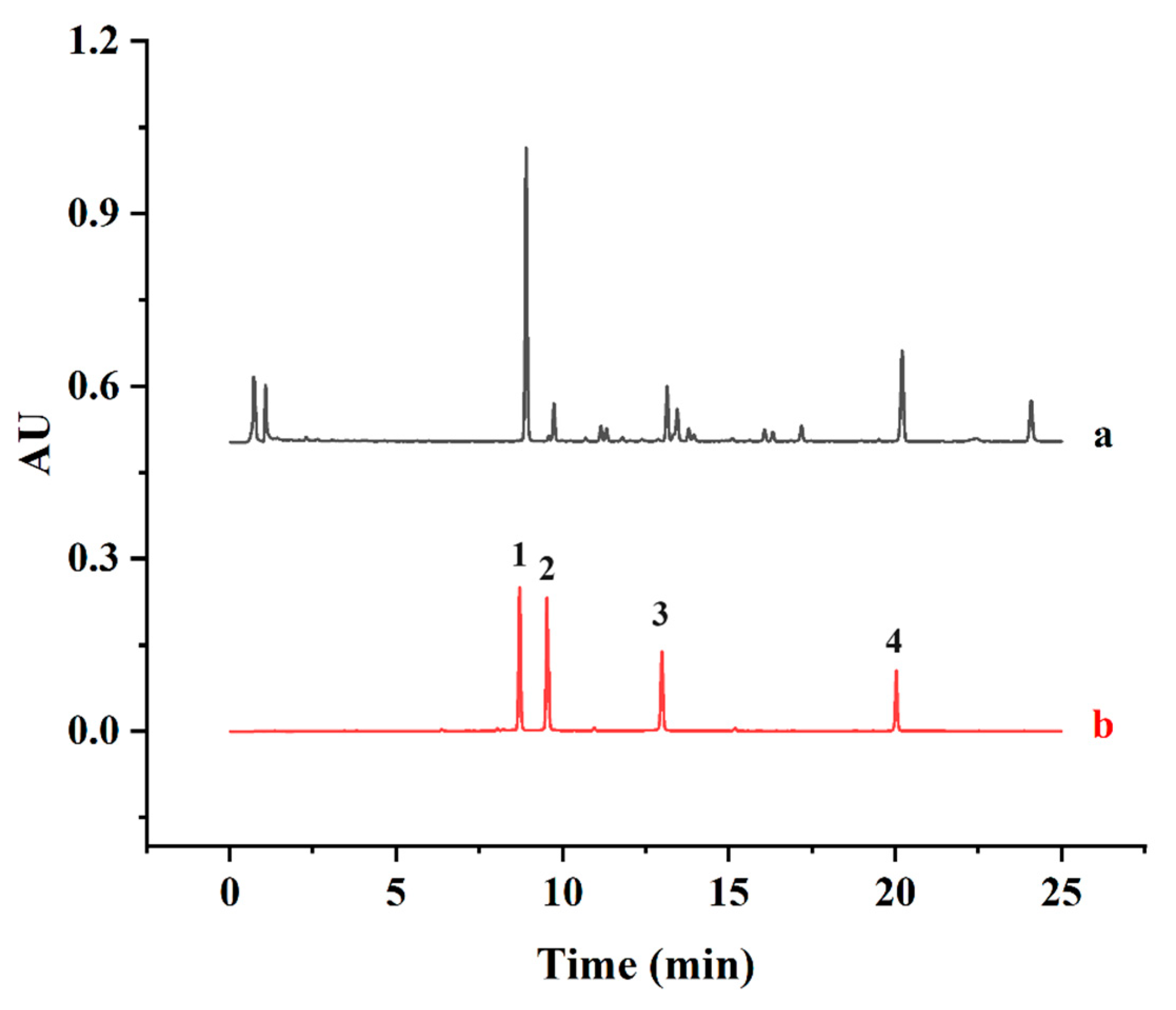
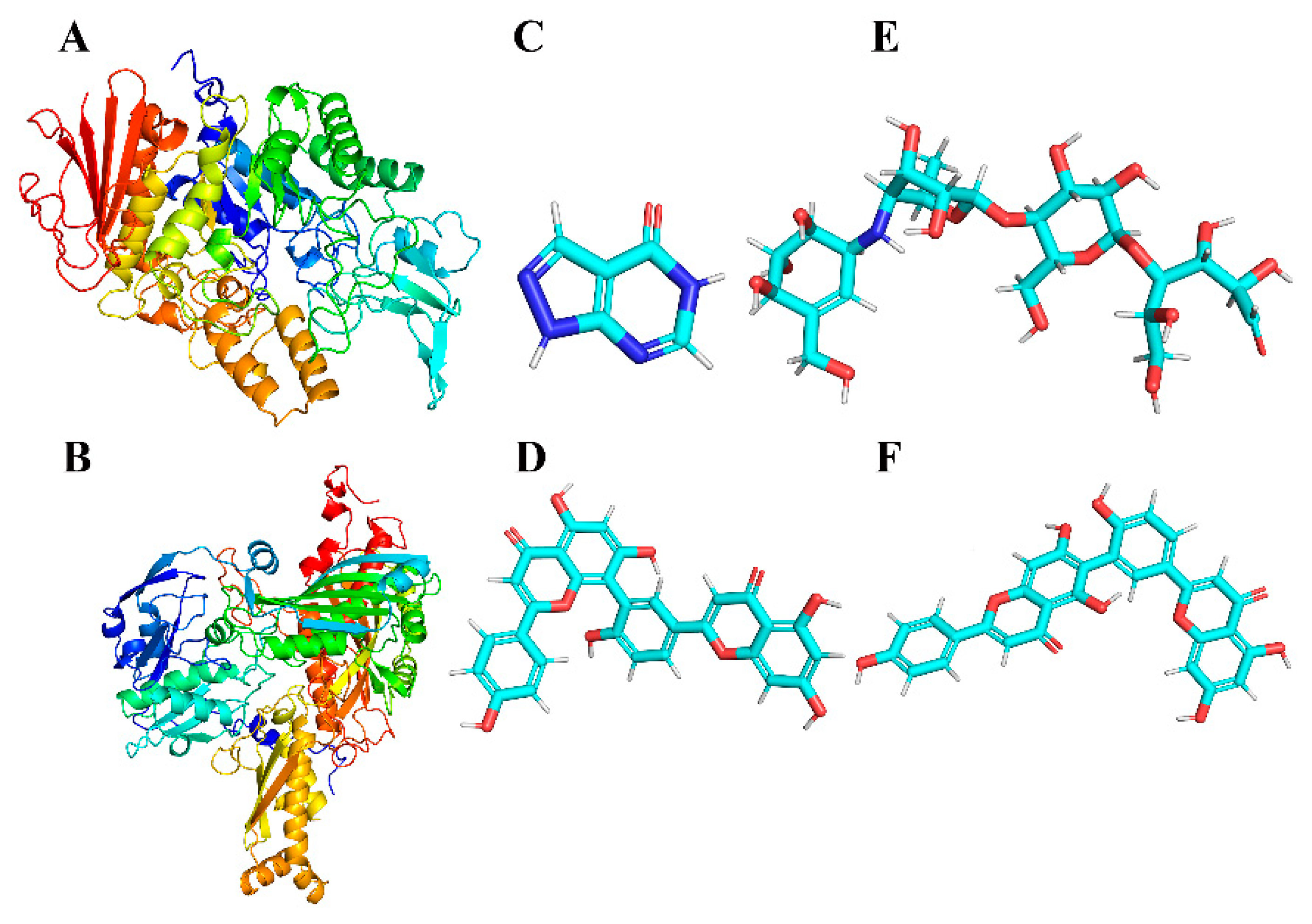
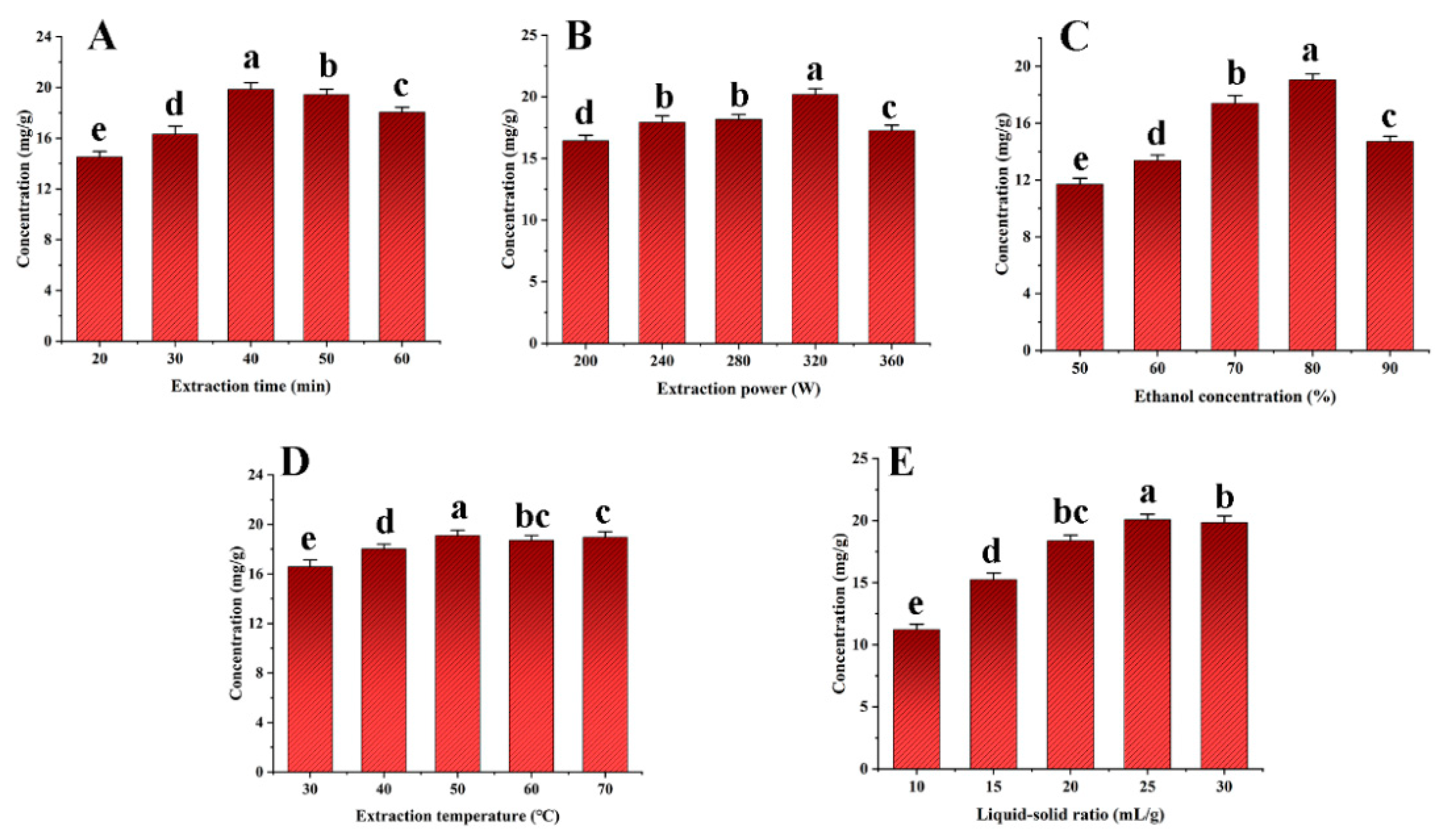

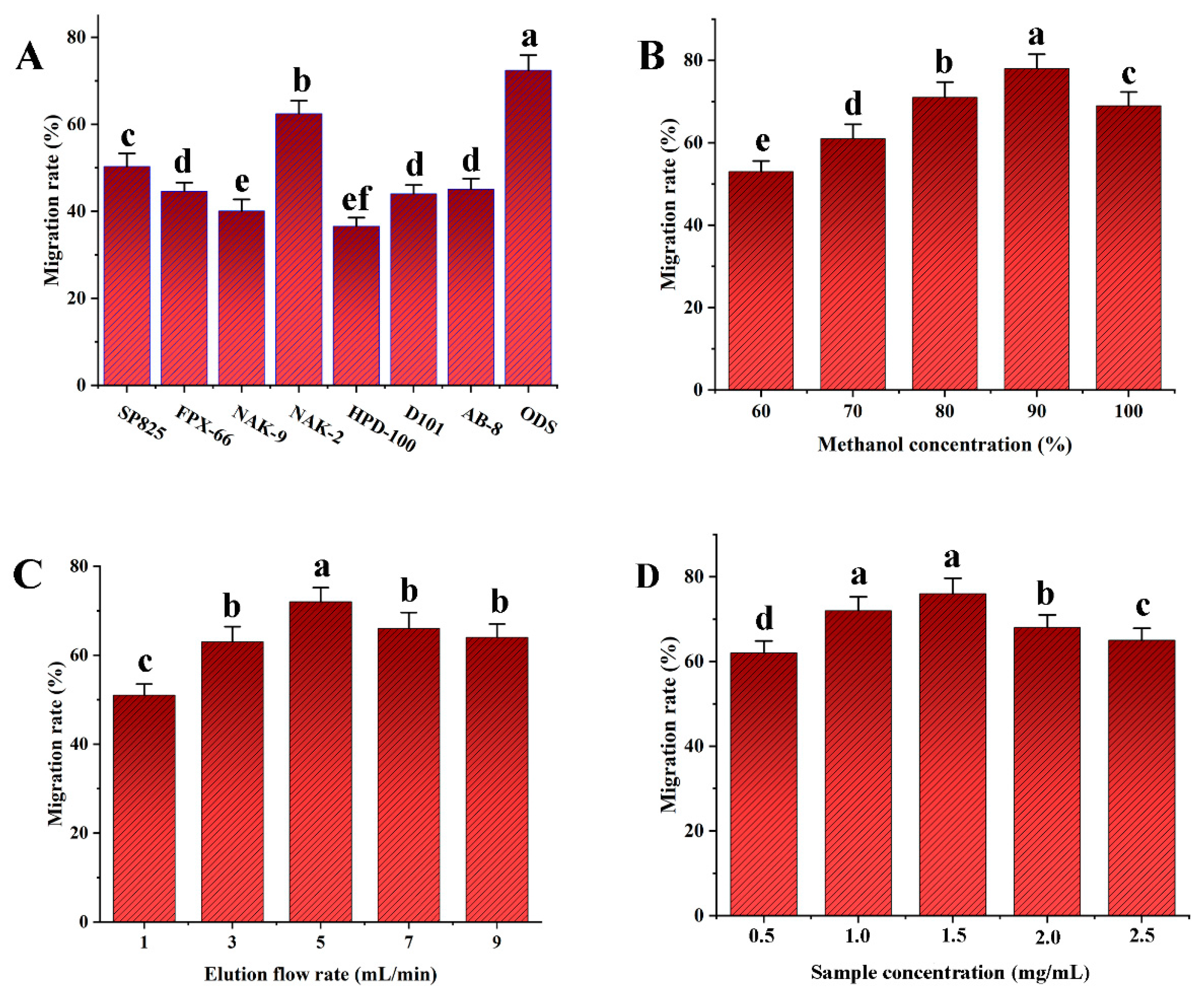

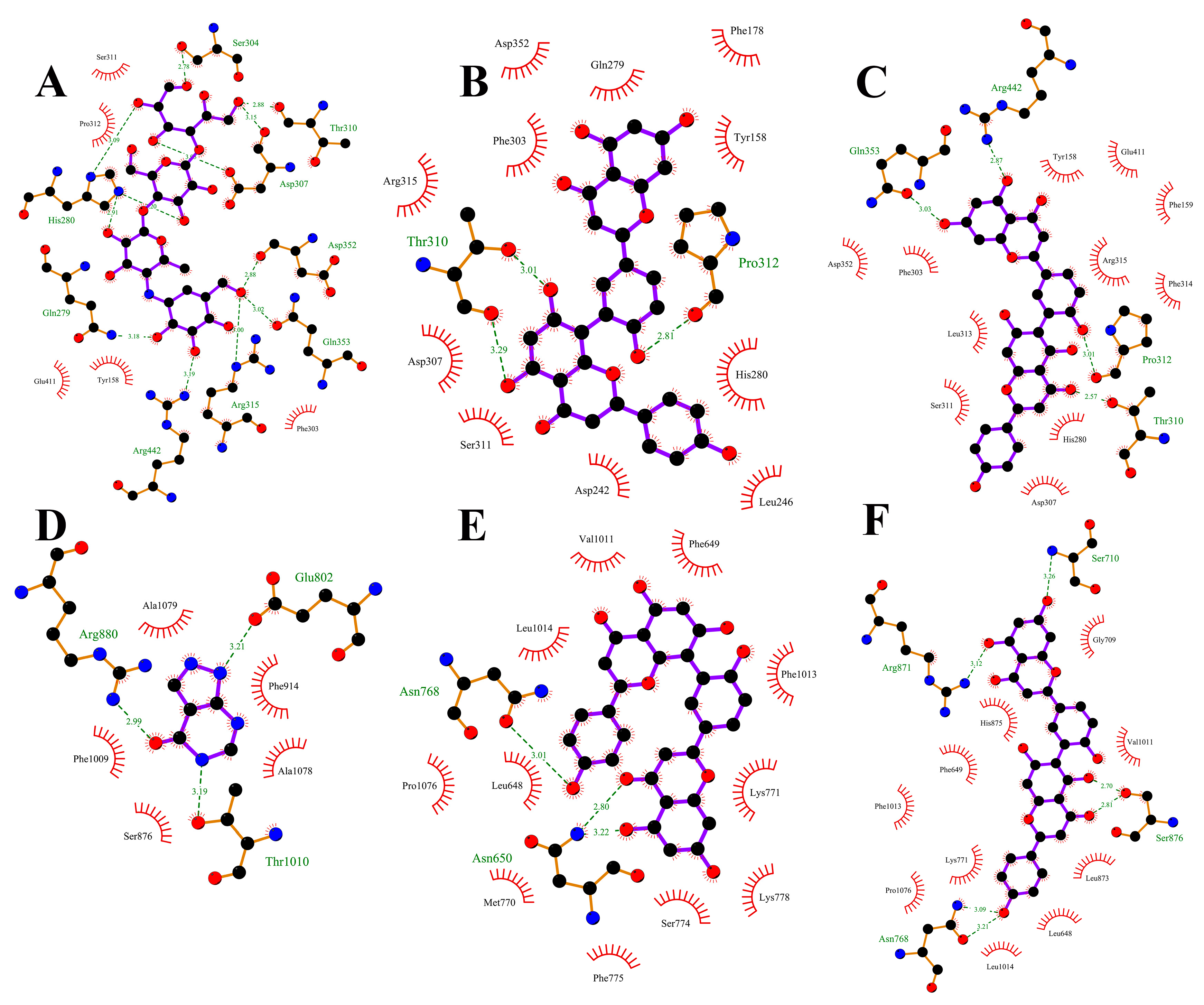


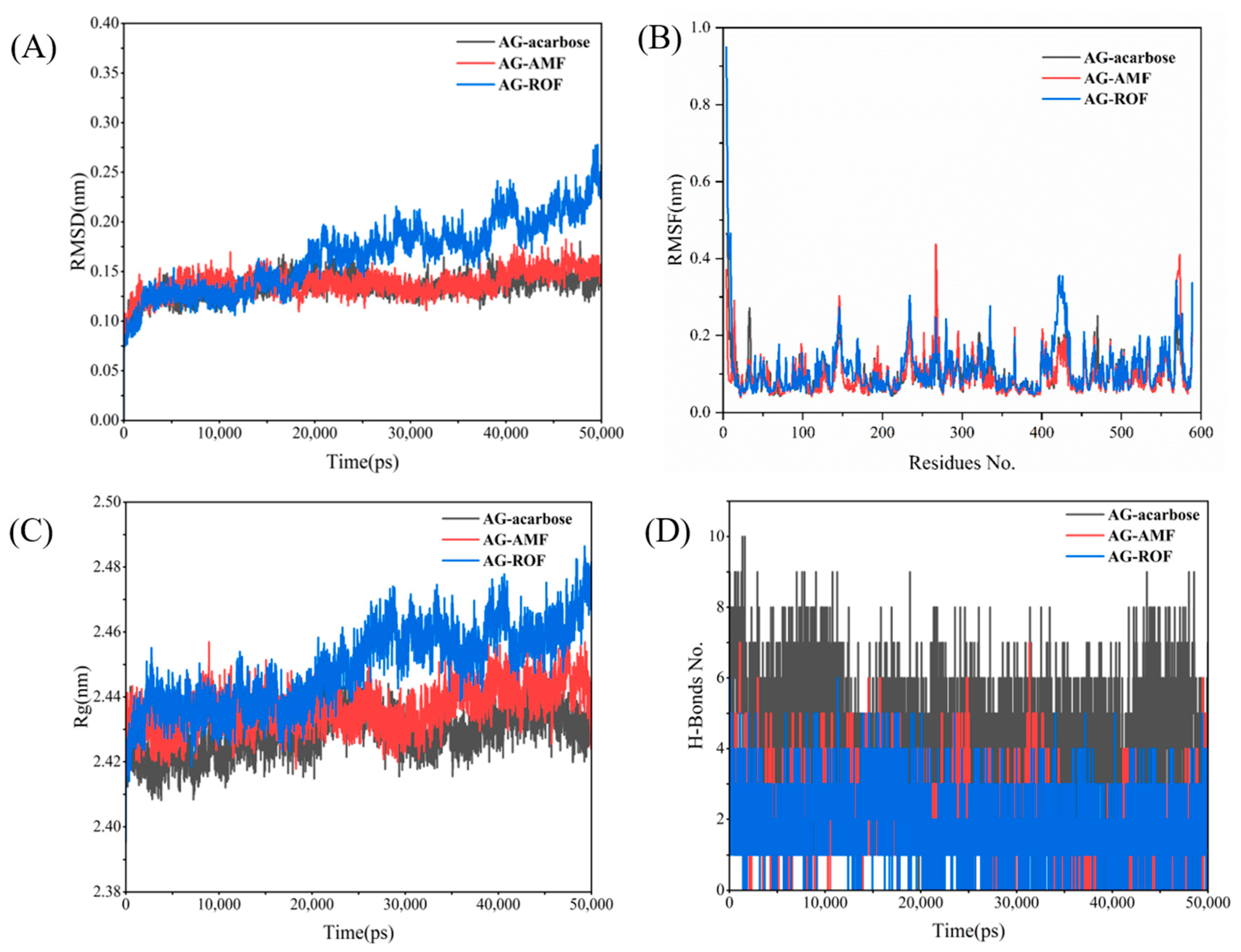
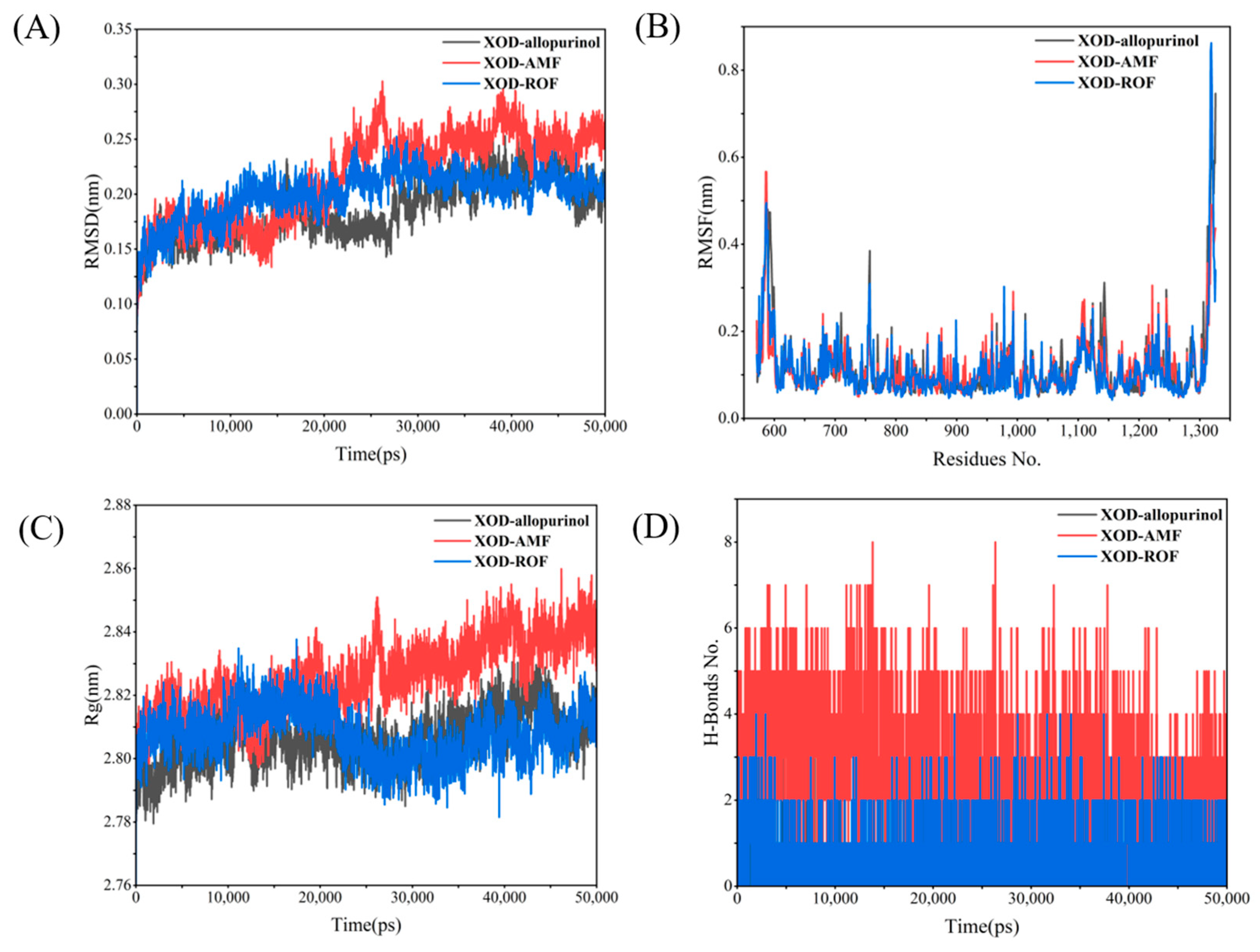
| Coding Factors | Unit | Coding Levels | ||
|---|---|---|---|---|
| −1 | 0 | 1 | ||
| A: extraction time | min | 30 | 40 | 50 |
| B: extraction power | W | 280 | 320 | 360 |
| C: ethanol concentration | % | 60 | 70 | 80 |
| Reagent | Control Group | Sample Group | Sample Blank Group |
|---|---|---|---|
| PBS buffer solution (0.1 mol/L) | 100 µL | 80 µL | 105 µL |
| α-glucosidase (0.2 U/mL) | 25 µL | 25 µL | \ |
| sample solution | \ | 20 µL | 20 µL |
| Incubate at 37 °C for 20 min | |||
| pNPG (4 mM) | 25 µL | 25 µL | 25 µL |
| Incubate at 37 °C for 15 min | |||
| Na2CO3 (0.2 mol/L) | 50 µL | 50 µL | 50 µL |
| Measurement of absorbance at 405 nm | |||
| Reagent | Control Group | Sample Group | Sample Blank Group |
|---|---|---|---|
| sample solution | \ | 500 µL | 500 µL |
| α-amylase (0.1 mg/mL) | 500 µL | 500 µL | \ |
| PBS buffer solution (0.1 M) | 500 µL | \ | 500 µL |
| Incubate at 37 °C for 10 min | |||
| 1% starch solution | 500 µL | 500 µL | 500 µL |
| Incubate at 37 °C for 10 min | |||
| DNS reagent | 1 mL | 1 mL | 1 mL |
| Boiled for 5 min, cooled and diluted with 10 mL of distilled water and finally the absorbance was measured at 540 nm | |||
| Reagent | Control Group | Control Blank Group | Sample Group | Sample Blank Group |
|---|---|---|---|---|
| PBS buffer solution (0.2 M, pH = 7.5) | 140 µL | 160 | 120 µL | 140 µL |
| XOD (0.1 U/mL) | 20 µL | \ | 20 µL | \ |
| sample solution | \ | \ | 20 µL | 20 µL |
| Incubate at 37 °C for 10 min | ||||
| xanthine (2 mM, pH = 7.5) | 20 µL | 20 µL | 20 µL | 20 µL |
| Incubate at 37 °C for 30 min | ||||
| HCl (1 M) | 40 µL | 40 µL | 40 µL | 40 µL |
| Measurement of absorbance at 290 nm | ||||
| No. | A (min) | B (W) | C (%) | Y (mg/g) |
|---|---|---|---|---|
| 1 | 30 | 320 | 70 | 17.62 |
| 2 | 40 | 360 | 70 | 16.44 |
| 3 | 40 | 280 | 90 | 18.36 |
| 4 | 30 | 280 | 80 | 20.60 |
| 5 | 40 | 320 | 80 | 22.07 |
| 6 | 50 | 320 | 70 | 19.01 |
| 7 | 50 | 360 | 80 | 18.93 |
| 8 | 30 | 360 | 80 | 19.39 |
| 9 | 40 | 320 | 80 | 22.20 |
| 10 | 40 | 320 | 80 | 22.45 |
| 11 | 30 | 320 | 90 | 19.18 |
| 12 | 40 | 280 | 70 | 19.85 |
| 13 | 40 | 360 | 90 | 18.78 |
| 14 | 40 | 320 | 80 | 22.28 |
| 15 | 50 | 280 | 80 | 21.01 |
| 16 | 50 | 320 | 90 | 19.69 |
| 17 | 40 | 320 | 80 | 21.81 |
| Source | Sum of Squares | df | F Value | p Value | R2 | R2 (Adj) | Significant |
|---|---|---|---|---|---|---|---|
| Model | 49.81 | 9 | 40.19 | <0.0001 | 0.9810 | 0.9566 | significant |
| A | 0.419 | 1 | 3.04 | 0.1247 | |||
| B | 4.92 | 1 | 35.73 | 0.0006 | |||
| C | 1.19 | 1 | 8.65 | 0.0217 | |||
| AB | 0.1876 | 1 | 1.36 | 0.2813 | |||
| AC | 0.1939 | 1 | 1.41 | 0.2741 | |||
| BC | 3.67 | 1 | 26.67 | 0.0013 | |||
| A2 | 2.91 | 1 | 21.14 | 0.0025 | |||
| B2 | 7.66 | 1 | 55.65 | 0.0001 | |||
| C2 | 25.39 | 1 | 184.37 | <0.0001 | |||
| Residual | 0.964 | 7 | |||||
| Lack of Fit | 0.7363 | 3 | 4.31 | 0.096 | not significant | ||
| Pure Error | 0.2278 | 4 | |||||
| Cor Total | 50.78 | 16 |
| Analyte | Calibration Curve | R2 | LOD (μg/mL) | LOQ (μg/mL) | Intraday Precision (n = 6) a | Interday Precision (n = 6) a | Stability (n = 7) a | Repeatability (n = 6) a | Recovery (n = 9) a |
|---|---|---|---|---|---|---|---|---|---|
| AMF | y = 34861261X − 33697 | 0.9992 | 0.535 | 1.567 | 1.17 | 1.32 | 0.72 | 0.51 | 0.89 |
| ROF | y = 29882101X + 21698 | 0.9994 | 0.615 | 1.904 | 0.89 | 1.15 | 1.88 | 1.14 | 1.03 |
| HIF | y = 35384525X − 19170 | 0.9992 | 0.279 | 0.862 | 1.05 | 1.47 | 1.48 | 1.01 | 1.52 |
| HEF | y = 34681114X − 3119 | 0.9995 | 0.118 | 0.352 | 1.06 | 1.14 | 1.12 | 1.16 | 1.58 |
| Proteins | Small Molecules | Binding Energies (kcal/mol) |
|---|---|---|
| AG | acarbose | −7.810 |
| AMF | −10.40 | |
| ROF | −11.33 | |
| XOD | allopurinol | −6.338 |
| AMF | −9.962 | |
| ROF | −10.21 |
| No. | ΔEVDW (kcal/mol) | ΔEEEL (kcal/mol) | ΔGGB (kcal/mol) | ΔGEURF (kcal/mol) | ΔGbind (kcal/mol) |
|---|---|---|---|---|---|
| AG–acarbose | −69.24 | −382.16 | 432.55 | −8.35 | −27.21 |
| AG–AMF | −57.38 | −16.73 | 38.54 | −6.44 | −42.00 |
| AG–ROF | −71.53 | −18.13 | 43.96 | −7.64 | −53.34 |
| XOD–allopurinol | −20.76 | −0.92 | 7.94 | −2.64 | −16.39 |
| XOD–AMF | −80.03 | −7.15 | 39.98 | −7.45 | −54.65 |
| XOD–ROF | −95.08 | −12.93 | 34.88 | −9.24 | −81.37 |
Disclaimer/Publisher’s Note: The statements, opinions and data contained in all publications are solely those of the individual author(s) and contributor(s) and not of MDPI and/or the editor(s). MDPI and/or the editor(s) disclaim responsibility for any injury to people or property resulting from any ideas, methods, instructions or products referred to in the content. |
© 2024 by the authors. Licensee MDPI, Basel, Switzerland. This article is an open access article distributed under the terms and conditions of the Creative Commons Attribution (CC BY) license (https://creativecommons.org/licenses/by/4.0/).
Share and Cite
Gao, Q.; Qiao, L.; Hou, Y.; Ran, H.; Zhang, F.; Liu, C.; Kuang, J.; Deng, S.; Jiang, Y.; Wang, G.; et al. Antidiabetic and Antigout Properties of the Ultrasound-Assisted Extraction of Total Biflavonoids from Selaginella doederleinii Revealed by In Vitro and In Silico Studies. Antioxidants 2024, 13, 1184. https://doi.org/10.3390/antiox13101184
Gao Q, Qiao L, Hou Y, Ran H, Zhang F, Liu C, Kuang J, Deng S, Jiang Y, Wang G, et al. Antidiabetic and Antigout Properties of the Ultrasound-Assisted Extraction of Total Biflavonoids from Selaginella doederleinii Revealed by In Vitro and In Silico Studies. Antioxidants. 2024; 13(10):1184. https://doi.org/10.3390/antiox13101184
Chicago/Turabian StyleGao, Qiong, Lei Qiao, Yiru Hou, Hailin Ran, Feng Zhang, Chao Liu, Juxiang Kuang, Shixing Deng, Yongmei Jiang, Gang Wang, and et al. 2024. "Antidiabetic and Antigout Properties of the Ultrasound-Assisted Extraction of Total Biflavonoids from Selaginella doederleinii Revealed by In Vitro and In Silico Studies" Antioxidants 13, no. 10: 1184. https://doi.org/10.3390/antiox13101184





